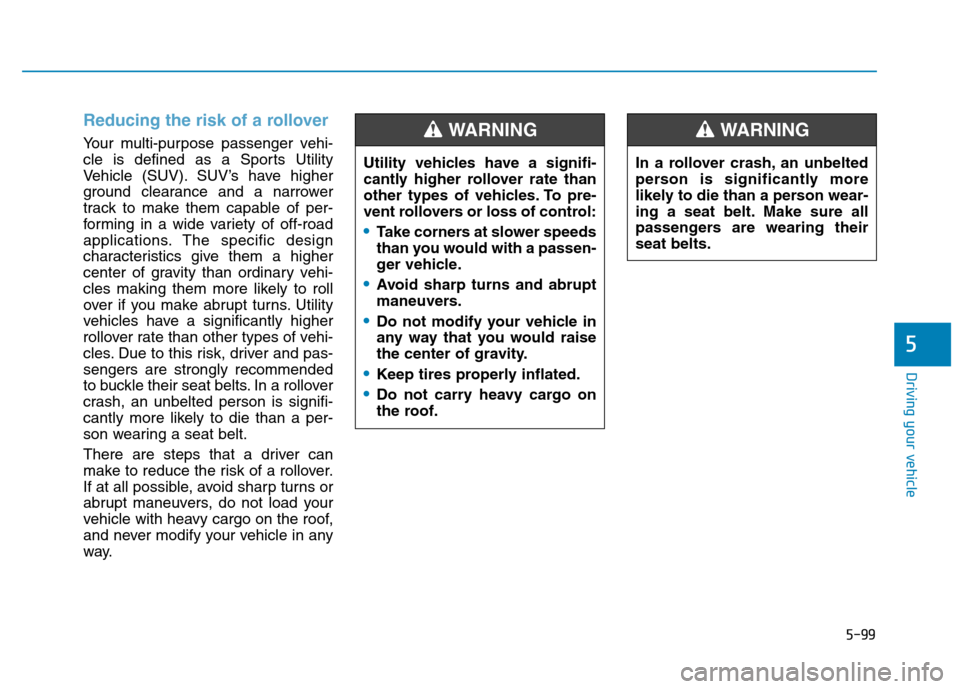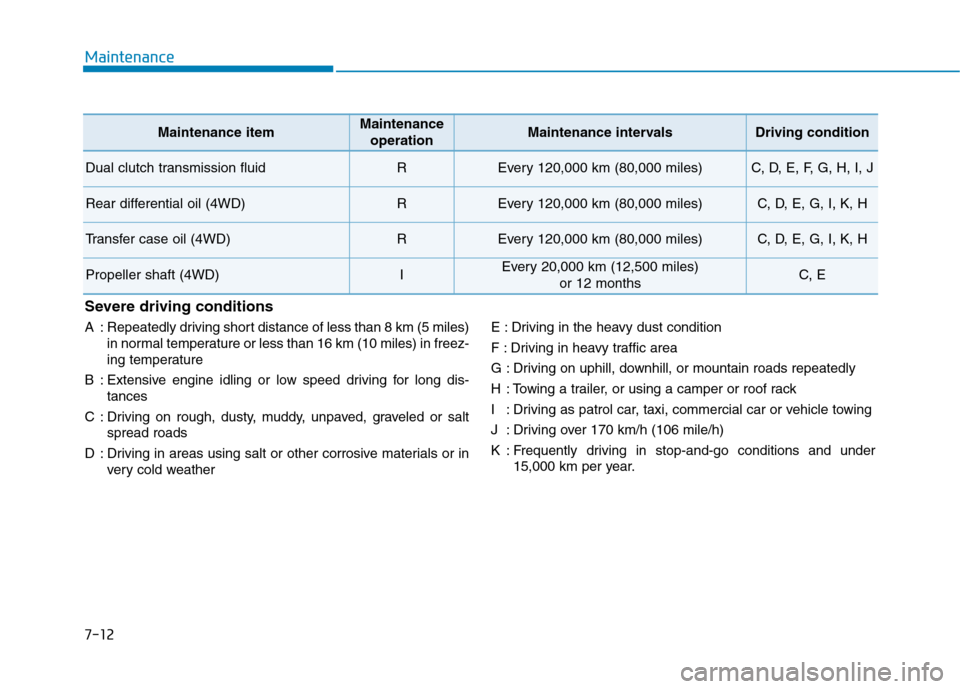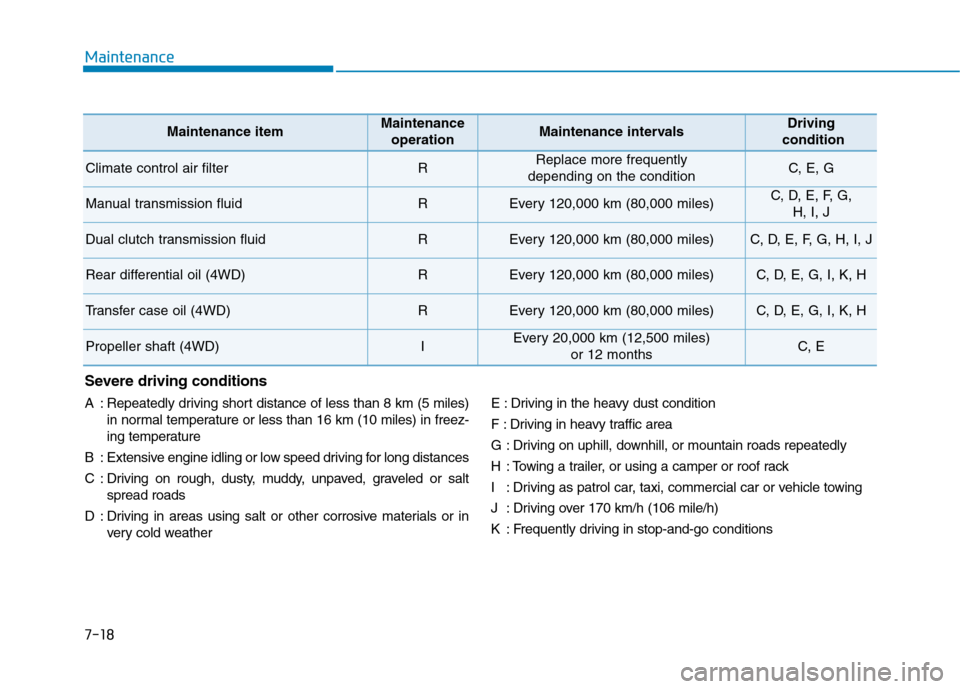Page 223 of 523

4-2
Multimedia System
Information
If you install an aftermarket HID headlamp, your vehicle’s audio and
electronic devices may malfunction.
Prevent chemicals such as perfume, cosmetic oil, sun cream, hand clean-
er, and air freshener from contacting
the interior parts because they may
cause damage or discoloration.
AUX, USB and iPod ®
port
You can use an AUX port to connect
audio devices and an USB port to plug
in an USB and an iPod ®
port. Information
When using a portable audio device
connected to the power outlet, noise
may occur during playback. If this
happens, use the power source of the
portable audio device. ❈ iPod ®
is a trademark of Apple Inc.
Antenna
Roof antenna
The roof antenna receives transmit-
ted data. (For example : AM/FM,
DAB, GPS/GNSS)Rotate the roof antenna in a counter-
clockwise direction to remove it. Rotate it in a clockwise direction toreinstall it.
Before entering a place with low
height clearance or a car wash,
remove the antenna by rotating it
counterclockwise. If not, the
antenna may be damaged.
When reinstalling your antenna, it is important that it is fullytightened and adjusted to the
upright position to ensure prop-er reception.
Do not clean the inside of the rear window glass with a cleaner
or use a scraper to remove for-
eign deposits as this may cause
damage to the antenna elements.
Avoid adding metallic coatings such as Ni, Cd, and so on. Thesecan degrade the received AM
and FM broadcast signals.
NOTICE
NOTICE
ii
MM UULLTT IIMM EEDD IIAA SS YY SSTT EEMM
OOS047071
OOS047074
Page 353 of 523

5-99
Driving your vehicle
5
Reducing the risk of a rollover
Your multi-purpose passenger vehi-
cle is defined as a Sports Utility
Vehicle (SUV). SUV’s have higher
ground clearance and a narrower
track to make them capable of per-
forming in a wide variety of off-road
applications. The specific design
characteristics give them a higher
center of gravity than ordinary vehi-
cles making them more likely to roll
over if you make abrupt turns. Utility
vehicles have a significantly higher
rollover rate than other types of vehi-
cles. Due to this risk, driver and pas-sengers are strongly recommended
to buckle their seat belts. In a rollover
crash, an unbelted person is signifi-
cantly more likely to die than a per-
son wearing a seat belt.
There are steps that a driver can
make to reduce the risk of a rollover.
If at all possible, avoid sharp turns or
abrupt maneuvers, do not load your
vehicle with heavy cargo on the roof,
and never modify your vehicle in any
way.Utility vehicles have a signifi-
cantly higher rollover rate than
other types of vehicles. To pre-
vent rollovers or loss of control:
Take corners at slower speeds
than you would with a passen-
ger vehicle.
Avoid sharp turns and abrupt
maneuvers.
Do not modify your vehicle in
any way that you would raise
the center of gravity.
Keep tires properly inflated.
Do not carry heavy cargo on
the roof.
WARNING
In a rollover crash, an unbelted
person is significantly more
likely to die than a person wear-
ing a seat belt. Make sure all
passengers are wearing theirseat belts.
WARNING
Page 424 of 523

Maintenance
7-12
Severe driving conditions
A : Repeatedly driving short distance of less than 8 km (5 miles)
in normal temperature or less than 16 km (10 miles) in freez-
ing temperature
B : Extensive engine idling or low speed driving for long dis- tances
C : Driving on rough, dusty, muddy, unpaved, graveled or salt spread roads
D : Driving in areas using salt or other corrosive materials or in very cold weather E : Driving in the heavy dust condition
F : Driving in heavy traffic area
G : Driving on uphill, downhill, or mountain roads repeatedly
H : Towing a trailer, or using a camper or roof rack
I : Driving as patrol car, taxi, commercial car or vehicle towing
J : Driving over 170 km/h (106 mile/h)
K : Frequently driving in stop-and-go conditions and under
15,000 km per year.
Maintenance itemMaintenance
operationMaintenance intervalsDriving condition
Dual clutch transmission fluidREvery 120,000 km (80,000 miles)C, D, E, F, G, H, I, J
Rear differential oil (4WD)REvery 120,000 km (80,000 miles)C, D, E, G, I, K, H
Transfer case oil (4WD)REvery 120,000 km (80,000 miles)C, D, E, G, I, K, H
Propeller shaft (4WD)IEvery 20,000 km (12,500 miles) or 12 monthsC, E
Page 430 of 523

Maintenance
7-18
Maintenance itemMaintenance operationMaintenance intervalsDriving
condition
Climate control air filterRReplace more frequently
depending on the conditionC, E, G
Manual transmission fluidREvery 120,000 km (80,000 miles)C, D, E, F, G, H, I, J
Dual clutch transmission fluidREvery 120,000 km (80,000 miles)C, D, E, F, G, H, I, J
Rear differential oil (4WD)REvery 120,000 km (80,000 miles)C, D, E, G, I, K, H
Transfer case oil (4WD)REvery 120,000 km (80,000 miles)C, D, E, G, I, K, H
Propeller shaft (4WD)IEvery 20,000 km (12,500 miles) or 12 monthsC, E
Severe driving conditions
A : Repeatedly driving short distance of less than 8 km (5 miles)in normal temperature or less than 16 km (10 miles) in freez-
ing temperature
B : Extensive engine idling or low speed driving for long distances
C : Driving on rough, dusty, muddy, unpaved, graveled or salt spread roads
D : Driving in areas using salt or other corrosive materials or in very cold weather E : Driving in the heavy dust condition
F : Driving in heavy traffic area
G : Driving on uphill, downhill, or mountain roads repeatedly
H : Towing a trailer, or using a camper or roof rack
I : Driving as patrol car, taxi, commercial car or vehicle towing
J : Driving over 170 km/h (106 mile/h)
K : Frequently driving in stop-and-go conditions
Page 447 of 523

7-35
7
Maintenance
By jump starting
After a jump start from a good bat-
tery, drive the vehicle for 20-30 min-
utes before it is shutoff. The vehicle
may not restart if you shut it off
before the battery had a chance to
adequately recharge. See “Jump
Starting” in chapter 6 for more infor-
mation on jump starting procedures.Information An inappropriately disposedbattery can be harmful to
the environment and human
health.
Dispose of the battery according to
your local law(s) or regulations.
Reset items
The following items may need to be
reset after the battery has been dis-
charged or the battery has been dis-connected.
Auto up/down window
Sunroof
Trip computer
Climate control system
Driver position memory system
Clock
Audio system
i
AGM battery (if equipped)
Absorbent Glass Matt (AGM) batteries are maintenance-free and we recommend that
the AGM battery be serviced
by an authorized HYUNDAI
dealer. For charging your
AGM battery, use only fully
automatic battery chargers
that are specially developed
for AGM batteries.
When replacing the AGM bat-
tery, we recommend that you
use parts for replacement
from an authorized HYUNDAI
dealer.
Do not open or remove the
cap on top of the battery. This
may cause leaks of internal
electrolyte that could result in
severe injury.
CAUTION
Page 463 of 523

7-51
7
Maintenance
Driver's side fuse Panel
Fuse NameSymbolFuse RatingCircuit Protected
MODULE5MODULE57.5A
ATM Shift Lever IND., Electro Chromic Mirror, Audio, AMP, Head Lamp RH,
A/V & Navigation Head Unit, A/C Control Module, Crash Pad Switch, Head Lamp LH,
ISG DC-DC Convertor, Auto Head Lamp Leveling Device Module,
Front Air Ventilation Seat Module, Front Seat Warmer Module
MODULE3MODULE37.5AStop Switch, BCM, ATM Shift Lever
S/ROOF20ASunroof Unit
T/Gate10ATail Gate Relay
P/WDW LHLH25APower Window LH Relay, Driver Safety Power Window Module (LHD)
Multi MediaMULTI
MEDIA15AISG DC-DC Convertor, Audio, A/V & Navigation Head Unit
P/WDW RHRH25APower Window RH Relay, Driver Safety Power Window Module (RHD)
DR/P/SeatDRV25ADriver Seat Manual Switch
PS/P/SeatPA SS25APassenger Seat Manual Switch
MODULE4MODULE47.5ABlind-Spot Collision Warning Unit LH/RH, Active Air Flap, BCM, Parking Distance Warning Buzzer,
Lane Keeping Assist Unit (Line), 4WD ECM
PDM337.5ASmart Key Control Module, Immobilizer Module
P/OUTLET2POWER
OUTLET
220AICM Relay Box (Power Outlet Relay)
Page 501 of 523
8-2
Specifications & Consumer informationD
D IIMM EENN SSIIOO NNSS
E
E NN GGIINN EE
ItemGasoline Engine
1.0 T-GDI 1.6 T-GDI
Displacement cc (cu. in)
997
(60.84)1591
(97.08)
Bore x Stroke mm (in.)
71.0 x 84.0
(2.79 x 3.30)77.0 x 85.44 (3.03x3.06)
Firing order
1-2-31-3-4-2
No. of cylinders
In-line 3 cylinderIn-line 4 cylinder
* 1
: with roof rack mm (in)
Itemsmm (in)
Overall length4165 (163.97)
Overall width1800 (70.86)
Overall height1550 (61.02) / 1565 (61.61)*
1
Front tread
205/60 R161575 (62.0)
215/55 R171563 (61.53)
235/45 R181559 (61.37)
Rear tread
205/60 R161584 (62.36)
215/55 R171572 (61.88)
235/45 R181568 (61.73)
Wheelbase2600 (102.36)
Page 502 of 523
8
Specifications & Consumer information
BBUU LLBB WW AATTTTAA GG EE
Light Bulb Bulb Type Wattage
Front Headlamp Low (Type A) H7 55
High (Type A) H7 55
Low (Type B) LED LED
High (Type B) LED LED
Low Beam Assist-static lamp H7 55
Turn signal lamp PY21W 21
Turn signal lamp (Outside mirror) LED LED
Daytime running lamp (DRL) / position lamp LED LED
Fog lamp H8 35
Rear Rear combination lamp Stop/Tail (Type A) P21/5W 21/5
Tail (Type A) W5W 5
Stop/Tail (Type B) LED LED
Turn signal P21W 21
Back up P21W 21
Fog lamp PR21W 21
High mounted stop lamp LED LED
License plate lamp W5W 5
Interior Map lamp
W10W 10
Room lamp (with sunroof) FESTOON 8
Room lamp (without sunroof) FESTOON 10
Sunvisor lamp FESTOON 5
Tailgate room lampFESTOON10
Glove box lamp FESTOON 5
8-3